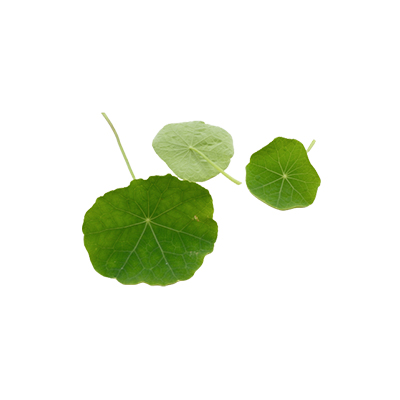Nasturtium
Tropaeolum majus L.
Tropaeolaceae
Location in our garden
Principal



Synonym
Cardamindum majus (L.) Moench
Nasturtium indicum Garsault
Tropaeolum atrosanguineum Gordon
Habitus
Climbers. An annual to short-lived perennial plant, growing 30 cm to 3,5 m long
Part Used
Leaves
Flowers
The Whole Plant
Growing Requirements
Full Sunshine
Need Shade
Habitat
Wetland
Riverbanks
Coastal
Roadside
Shrublands
Overview
Originated from South America in the Andes Mountains from Peru, North Bolivia to Colombia. Introduced to Europe in the sixteenth century and elsewhere later. Nasturtium is not only planted for its beautiful flowers but also because the leaves and flowers can be eaten and used in salads. Nasturtium leaves as part of herbal treatment are highly recommended because of years of experience and the latest research found that nasturtium leaves are very effective in promoting new blood cell formation in the body. Dry ripe seeds can be ground into powder and are used as a substitute for pepper or pressed to make oil. Nasturtium has long been used in Andean herbal medicine as a disinfectant and wound-healing herb, and as an expectorant to relieve chest conditions.
Vernacular Names
No information found. Need further search.
Agroecology
Found growing on coastal and disturbed areas from sea level to 3,000 m. A plant of the tropics, it can be cultivated as an annual in the temperate zone. Tolerates most soils, though it prefers a rich light well-drained soil in full sun or partial shade. More and lusher leaves are produced when the plant is growing in a rich soil, though less flowers are produced. When grown in a soil of low fertility the leaves are smaller and less lush, though more flowers are produced.
Morphology
- Roots - short and branched.
- Stems - creeping and brittle, pale green, hairless, slightly fleshy, soft, tortuous.
- Leaves - green or grayish-green above but pale below, borne on 5-30 cm petioles, attached to the lower center of the leaf, round with flat wavy or slightly lobed leaf margins. The leaves are glabrous and have many prominent veins radiating outward from the center of the leaf blade.
- Flowers - hermaphrodite, resembling a small trumpet, measuring 2.5-7 cm in length, having five yellow, orange or red crowns petals 2.5-6 cm long, five sepals 1-2 cm long fused at the base. One of these sepals is formed into a nectar-bearing spur (2.5-4 cm long) that is straight or slightly curved. It has 8 stamens and an ovary on top with a style and stigma.
- Fruits - schizocarp that divides into 3 wrinkled paprikarp, yellow-green turning to yellow-grey, each segment/carpel has one large seed. Pale green initially turns to pale brown as it ripens.
- Seeds - large, ovoid in shape with prominent elongated protuberances.
Cultivation
Propagated by seeds - sow in situ. The seed usually germinates within 2 weeks.
Chemical Constituents
Carotenoids (violaxanthin, antheraxanthin, lutein, zeaxanthin, zeinoxanthin, β-cryptoxanthin, α-carotene, β-carotene), beta carotene, glycosides, flavonoids (quercetin, isoquercetin, quercetin 3-glucoside, myricetin, kaempferol, pelargonidin, cyanidin, delphinidin, derivatives of hydroxycinnamic acid), polyphenols, glucosinolates (benzyl glucosinolate (glucotropaeolin), sinalbine), fatty acids (erucic acid, oleic acid, linoleic acid).
Traditional Medicinal Uses
- All parts of the plant appear to be antibiotic and an infusion of the leaves can be used to increase resistance to bacterial infections and to clear nasal and bronchial catarrh. The remedy seems to both reduce catarrh formation and stimulate the clearing and coughing up of phlegm.
- The leaves are antibacterial, antifungal, antiseptic, aperient, depurative, diuretic, emmenagogue, expectorant, laxative and stimulant. A glycoside found in the plant reacts with water to produce an antibiotic.
- Extracts from the plant have anticancer activity.
- The plant is taken internally in the treatment of genito-urinary diseases, respiratory infections, scurvy and poor skin and hair conditions.
- Externally it makes an effective antiseptic wash and is used in the treatment of baldness, minor injuries and skin eruptions.
Part Used
Reference Sources
- Royal Botanic Gardens. Plants of the World Online. Tropaeolum majus L. https://powo.science.kew.org/taxon/urn:lsid:ipni.org:names:310974-2. 02-07-22.
- Healthbenefitstimes.com. Health benefits of Indian Cress. https://www.healthbenefitstimes.com/indian-cress/. 02-07-22.
- Tropical Plants Database, Ken Fern. 2021. Tropaeolum majus. https://tropical.theferns.info/viewtropical.php?id=Tropaeolum+majus. 02-07-22.
- Brondani et al. 2016. Traditional usages, botany, phytochemistry, biological, biological activity abd toxicology of Tropaeolum majus L. A Review. Boletín Latinoamericano y del Caribe de Plantas Medicinales y Aromáticas 15 (4).


